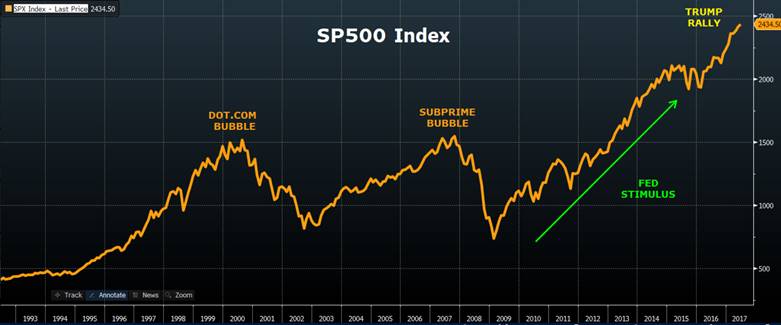Below, we look at the best way to invest in a bad market that offers far more risk than reward.
Lessons from a Surf Spot
In Costa Rica, the waves are big, and for surfers paddling into them (duck-dive after duck-dive after duck-dive…) the trip past the waves and out to the line-up can be exhausting. Just as you rise to the surface, another shiny, blue swell is right on top of you.
By the time you get past all the pummeling of the ocean, your arms can feel like Jello. Well, it’s the same with these markets. They are getting a little tired, a little…you know: “Jello-ish.”
After years of artificially smooth market conditions (thanks to the geniuses at the Fed and over a decade of distorting free price-discovery via suppressed interest rates, reckless money printing and deficits without tears), the growing and dangerous market wave the Fed arrogantly tried to control is proving once again that the laws of markets, like the laws of a nature, are stronger than any surfboard or Fed Chairman…
Cutting Through the Sell-Side Fog
As of this writing, the markets are getting clobbered like a pack of long-boarders in 20-foot surf… This week, the NASDAQ, DOW and S&P have seen consecutive days of 2-3% losses.
As usual, the bubble-heads of the financial media (aka: the sell-side hope peddlers) have a new excuse each day. In October it was tech stocks, in November it was earnings and this month it’s all about the China Deal.
And, as usual—that’s all just fog.
For example, when the markets were down in October, the prompt readers immediately rolled out a tech sector excuse; but if the markets climbed the next day, the same bubble-heads credited the “rebound” to –-and you guessed it: a tech sector puff piece.
This month, it’s the same charade.
When markets climbed briefly after Trump’s historic “China Deal” in Argentina (which, as I wrote that same day, was no deal at all…), the marketing cheerleaders of Wall Street, disguised as financial experts, immediately sang the praises of the new Tariff breakthrough.
The next day, as markets went south, those same talking-heads and headline-writers began to blame it on the suddenly “flawed” China deal.
You get the drift: it’s just noise, paddling in circles. Nonsense.
Ignoring the Elephant in the Room: Debt
These “experts” ignore the elephant in the room because unlike the tabloid/MSM media, which thrives on fear, bad news and drama, the bubble-head financial media thrives on hope, bullish memes and temporary spin-cycles.
After all, the financial industrial complex lives on fees, and fees are higher when markets—and hence portfolios and clients—are higher. This means the experts want to make you feel “high” even when the facts say otherwise.
Ever since the Fed stepped past Main Street and artificially saved the top 10% of America via an artificial stock-market recovery in 2008, such hope-selling was easy. Indeed, we’ve had over a decade where markets only went up and hence the sales-pitch noise was easy to absorb.
A lot of these financial reporters and “experts” kind of remind me of some guy sitting at the wheel of a fancy car. He’s bragging about the leather seats, his Blaupunkt stereo, the sweet set of woofers he had installed and the fancy Porsche logo on the steering wheel.
In short: he loves the surface shine and the cool sounds.
But what he’s not seeing is the four flat tires, the broken brake pads, a clogged fuel injector and the muffler dragging on the road…
Look Under the Hood
It’s the same when the bubble-heads roll out the standard “everything is fine meme”—i.e. the happy (yet entirely fictional) “surging earnings, roaring GDP and record employment” memes we’ve been bombarded with as recently, as well, last week…
In short: the sell-side faith-peddlers don’t like to talk about the elephant, or the flat tires…They like to talk about “happily ever after” and the surface of things—like a market that only seemed to go up, or fake earnings based on stock buy-backs and ex-items accounting rather than actual math…
What’s under the hood, of course, is just too ugly (and greasy) to look at. My role, fortunately, is to look under the hood for you.
And the elephant (or broken fuel-injector), of course, is a gigantic, four-legged debt beast of which I’ve written about here and here, or talked about here and here…
And as I warned in June and September, markets would begin to show volatility and point south in October and November.
This foreseeable sell-off in December is not because of the tech sector, or China or the tariff war (though I have argued that tech is grossly over-valued, China is a debt-soaked Ponzi scheme and the trade war is a terrible idea).
Instead, the real issue is obvious.
In fact, understanding this market’s destiny (and current Jello-arms) boils down to this: our bond market is a bubble, our stock market is massively over-valued, and our country is broke and at peak debt.
Problems Ahead
When you combine that debt elephant with a tightening Fed (i.e. one no longer buying US debt) and a government issuing more debt (i.e. US Treasuries)—well, you have a problem…
That is, as rates trend up in the backdrop of a debt-driven (and completely fake) “recovery,” the debt party we’ve gotten drunk on since 2008 ends with more pain than the pleasure we hitherto enjoyed. Full stop.
To make this even easier to see (and believe), I highly recommend you read this: The One Market Chart that Explains Everything—or take a look at this: Understanding the Current Market Volatility.
Not the End of the Party—Just the Early Signs
What we are seeing this week, however, is not the end of the party, but merely the first signs that we are running out of cold beer.
Yes, the hangover is coming, but the real puking has yet to begin, for all of the reasons I’ve warned about in prior segments here, here, here and here, and here, here and here…
How to Invest in a Bad Market?
With that so smugly said, the obvious question for many of you is this: If the party is about to end, and if markets have far more risk to offer than reward, just what the heck are you supposed to invest in? In short: do you paddle in, or paddle out?
Good question.
Let me give you a good answer.
Start with Common-Sense
The first (and most important) part of the answer boils down to common sense, a quality so otherwise ignored among the fluff of market supermen in suits spewing out Wall Street jargon on CNBC or Bloomberg TV…
That is, would anyone in their right mind buy a $50.00 pair of shoes marked up to $150? Or would you rather wait for those sneakers to go on sale for $20.00?
Although the answer seems obvious, 90% of market homosapiens do the very opposite. That is, they buy at tops (herd delusion) and sell at bottoms (herd panic).
Do you want to be a part of that herd?
Stated more simply: if you have a portfolio that is facing a massively overvalued market in the backdrop of history’s greatest national and global debt bubble, it should be fairly obvious that risk far outweighs reward.
In short, it should be fairly obvious that the best thing to invest in is anything but the stock and bond markets…
Then Go to Cash
Or stated even more simply—just get the hell to cash.
Perhaps you say NO! Perhaps you are afraid of missing out.
But missing out on what? There’s so little upside ahead, and so much downside to come, the best thing is to get off this Titanic market before it hits the iceberg.
I wrote about the magic of cash here, and I urge you to read it again.
Whether you’re a Texas billionaire or a millennial with a 401K at a cannabis start-up, the smart move today is to recognize the most important rule in getting stock-market rich, namely: that fortunes are made by not losing money.
In sum: Get out at these tops and get back in when the markets bottom. It’s that simple.
Some will argue, of course, that it’s impossible to know where the “top” is? Folks, there’s no crystal ball of perfect market timing…but, compared to prior bubbles… does this look like something close to a top?

Enough said.
Diversify the Non-Cash Portion of Your Money
Thirdly, and for those who are familiar with the concept of risk vs. uncertainty, a few of you more aggressive or savvy investor types may want to continue to have a little bit of skin in the markets—that is, you still want to do some trading, despite the volatility and risk ahead.
In fact, some of you may want to do some shorting or hedge your bearish views with at least some long market allocations.
Well, for subscribers of Signals Matter, we make this very easy: 1) we show you just how close the market iceberg ahead is (with sophisticated data, not clever blogs); 2) we give you specific cash percentage recommendations and 3) we offer a choice of three extremely smart asset allocation recommendations (conservative, moderate and aggressive, depending on one’s “type”) for the little money you still have at risk—i.e in the markets.
These remaining allocations include liquid alts, very specific, lower risk bond and stock allocations and some inverse ETF’s for those looking to short over-valued sectors (like, say, the FANGS… or Russell 2000) when the time is right.
Gold
We also recommend precious metals.
Why?
Because as debt bubbles crash, so too do currencies and broad asset classes across the equity spectrum. When traditional stocks and bonds go south, Gold, in particular, typically goes up.
Some, of course, disagree.
They think gold will go down due to deflation and credit defaults.
Perhaps. But we don’t think so. We think the opposite.
Nevertheless, we have to recognize that one cannot over-concentrate in any asset class, including gold—which is why we are not gold-bugs, just gold-smart. Keep gold somewhere in the 5%-10% range.
For non-subscribers, we hope the foregoing provides some common-sense guidance.
For those of you already part of the Signals Matter community as subscribers, you already know exactly where (and how much) to invest today and tomorrow.
And when these markets eventually bottom, you’ll also know (approximately, not perfectly) when to get back in the markets and buy at a discount rather than a premium.
And that, by the way, (and in a nutshell) is how fortunes are made.
The rest is all just fog. Fancy talk, yes, but still just fog…
If you follow Signals Matter and become a subscriber, you’ll be following a lighthouse, not rowing in the fog. You’ll be part of the art and science of buying low and selling high.
Again, this may sound obvious, but almost no one knows how to do it.
We do, so join us.
In the interim, be careful out there…



